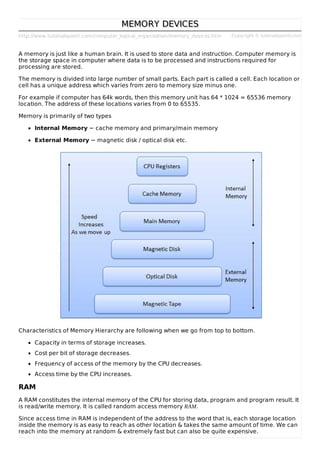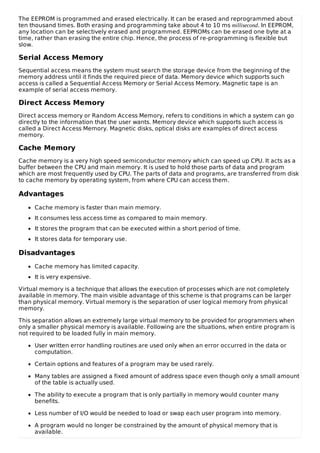Memory is used to store data and instructions and is divided into small parts called cells. There are two types of memory: internal memory (cache and main memory) and external memory (magnetic disks, optical disks). Memory characteristics like capacity, cost, and access time change as we move from top to bottom of the memory hierarchy. RAM is the main internal memory and can be accessed randomly, but is volatile. There are two types of RAM: SRAM and DRAM. ROM is non-volatile and can only be read from. Examples are ROM, PROM, EPROM, and EEPROM. Cache memory is very fast memory between the CPU and main memory. Virtual memory allows programs larger than physical memory.



![Each user program could take less physical memory, more programs could be run the same
time, with a corresponding increase in CPU utilization and throughput.
Auxiliary Memory
Auxiliary memory is much larger in size than main memory but is slower. It normally stores system
programs, instruction and data files. It is also known as secondary memory. It can also be used as
an overflow/virtual memory in case the main memory capacity has been exceeded. Secondary
memories cannot be accessed directly by a processor. First the data/information of auxiliary
memory is transferred to the main memory and then that information can be accessed by the CPU.
Characteristics of Auxiliary Memory are following −
Non-volatile memory − Data is not lost when power is cut off.
Reusable − The data stays in the secondary storage on permanent basis until it is not
overwritten or deleted by the user.
Reliable − Data in secondary storage is safe because of high physical stability of secondary
storage device.
Convenience − With the help of a computer software, authorised people can locate and
access the data quickly.
Capacity − Secondary storage can store large volumes of data in sets of multiple disks.
Cost − It is much lesser expensive to store data on a tape or disk than primary memory.
Loading [MathJax]/jax/output/HTML-CSS/jax.js](https://image.slidesharecdn.com/memorydevices-170304171438/85/Memory-devices-4-320.jpg)